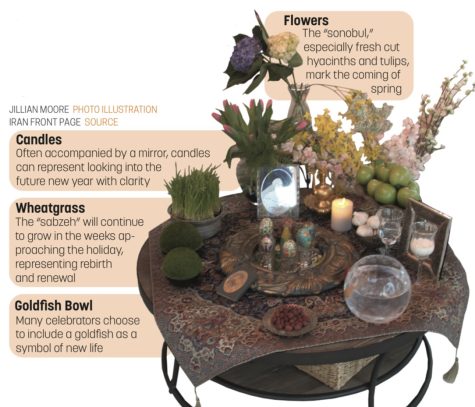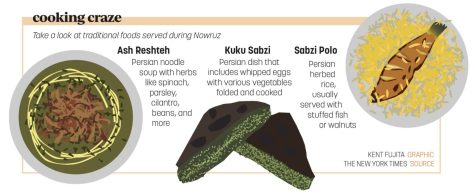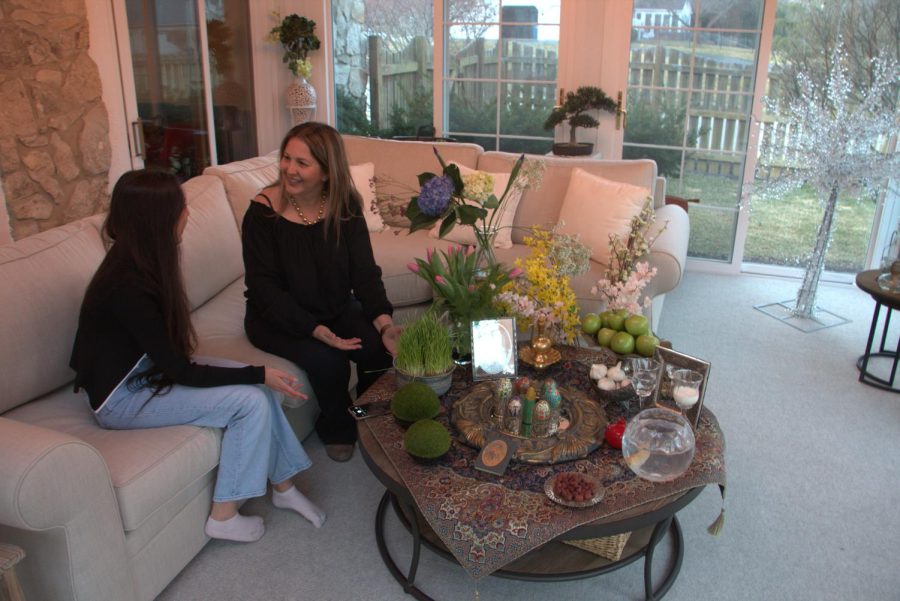Outside, crowds stand in the cold to wait for the ball to drop in Times Square. Inside, glasses clink together while people strike up conversations about their resolutions for the coming year. New Year’s Eve is one of the biggest celebrations of the year and it’s also America’s fourth favorite holiday, according to a statistic provided by FiveThirtyEight.
But for freshman Aksi Adilet-Sultan, she would have to put off her New Year’s celebration until the spring month of April. She celebrates Nowruz, a holiday celebrated by many cultures in the Middle East and Asia. It’s a way to welcome the start of spring and an opportunity for a fresh start. It is on or around March 21, or in some areas on April 7. The celebration can last up to seven days depending on the country. It is also known as the Persian New Year or, in Adilet-Sultan’s case, the Kyrgyz New Year.
“I love this holiday. It’s like a fresh start to the year and [it] also makes me feel connected to Kyrgyzstan [and] Kyrgyz culture because, growing up in America, I didn’t have the opportunity to be connected to my culture,” Adilet-Sultan said.
Adilet-Sultan is not the only one who celebrates Nowruz at this school. She is among the few who knows about Nowruz and why it’s such an important holiday for many. For Persian-American Max Banan, Nowruz celebrations are no different now than when he was a child. Banan has been celebrating this holiday for almost 70 years, but the historical traditions and lessons still reside with him.

“The Nowruz celebration started over 2,600 years ago before the Persian Empire became strong. The Persians believed in the Zerashtin concept of honesty, friendship and care…” he said via email. “There is a sense of renewed goodwill and feeling for everybody.”
Junior Parisa Shirani said her family celebrates Nowrux in many ways, including grand parties for their relatives and friends. She said along with decorating a haft-seen, the Chaharshanbe Suri is one of these valued traditions.
“You jump over fire and then that symbolizes all the negativity in your life, it falls in the fire, it burns, it goes away,” she said.
For Adilet-Sultan, she said her favorite part about her Nowruz celebration is eating “somolok”, a traditional Kyrgyz wheat soup. Somolok also has its own history. People made it at the start of spring to fight off hunger, as there was no central government in Kyrgyzstan at the time to help the people. Adilet-Sultan said somolok became the traditional Nowruz food for Kyrgyz people and she thinks of it as a symbol of perseverance through tough times. 
Banan said as a child, he loved receiving candy and money from relatives as well as the parties that went on for seven days. He said he enjoyed spending time with family who otherwise lived out of town and he said it was an exciting part about Nowruz.
Like Banan, many families get together and connect with one another during the time of Nowruz. For people like freshman Sofia Molavi, Nowruz became a time for gratitude and commemoration as she got older.
“When I was younger, I used to have a lot of Persian family here. Then a lot of them went back to Iran or they passed away,” Molavi said. “It became a day to think about my loved ones and appreciate a lot more things. So it’s also a holiday of gratitude…”
Shirani said the weekend before Nowruz, there is a party in Indianapolis which hundreds of people attend. She said it was a way for the Irani community to celebrate together and shows the holiday’s importance.
Despite all the cherished memories and special holiday traditions that Nowruz has to offer, it is a holiday that is otherwise often overlooked when talking about celebrations. Molavi said this school is exclusive to a point where few people know what goes on in other peoples’ lives. Adilet-Sultan said in her experience, most people who were not of Middle Eastern or Central Asian descent did not know what Nowruz was.
“Cultural connection has a huge impact on people’s behavior. By having contact with other people, [it] will produce friendships which could be helpful at times of crisis,” Banan said.
“It’s important to learn about other cultures because it opens our eyes to different peoples and their individual practices,” Adilet-Sultan said. “Celebrating these holidays makes me feel like I really am Kyrgyz and that part of me is here.”































![What happened to theater etiquette? [opinion]](https://hilite.org/wp-content/uploads/2025/04/Entertainment-Perspective-Cover-1200x471.jpg)














































![Review: “The Immortal Soul Salvage Yard:” A criminally underrated poetry collection [MUSE]](https://hilite.org/wp-content/uploads/2025/03/71cju6TvqmL._AC_UF10001000_QL80_.jpg)
![Review: "Dog Man" is Unapologetically Chaotic [MUSE]](https://hilite.org/wp-content/uploads/2025/03/dogman-1200x700.jpg)
![Review: "Ne Zha 2": The WeChat family reunion I didn’t know I needed [MUSE]](https://hilite.org/wp-content/uploads/2025/03/unnamed-4.png)
![Review in Print: Maripaz Villar brings a delightfully unique style to the world of WEBTOON [MUSE]](https://hilite.org/wp-content/uploads/2023/12/maripazcover-1200x960.jpg)
![Review: “The Sword of Kaigen” is a masterpiece [MUSE]](https://hilite.org/wp-content/uploads/2023/11/Screenshot-2023-11-26-201051.png)
![Review: Gateron Oil Kings, great linear switches, okay price [MUSE]](https://hilite.org/wp-content/uploads/2023/11/Screenshot-2023-11-26-200553.png)
![Review: “A Haunting in Venice” is a significant improvement from other Agatha Christie adaptations [MUSE]](https://hilite.org/wp-content/uploads/2023/11/e7ee2938a6d422669771bce6d8088521.jpg)
![Review: A Thanksgiving story from elementary school, still just as interesting [MUSE]](https://hilite.org/wp-content/uploads/2023/11/Screenshot-2023-11-26-195514-987x1200.png)
![Review: "When I Fly Towards You", cute, uplifting youth drama [MUSE]](https://hilite.org/wp-content/uploads/2023/09/When-I-Fly-Towards-You-Chinese-drama.png)
![Postcards from Muse: Hawaii Travel Diary [MUSE]](https://hilite.org/wp-content/uploads/2023/09/My-project-1-1200x1200.jpg)
![Review: "Ladybug & Cat Noir: The Movie," departure from original show [MUSE]](https://hilite.org/wp-content/uploads/2023/09/Ladybug__Cat_Noir_-_The_Movie_poster.jpg)
![Review in Print: "Hidden Love" is the cute, uplifting drama everyone needs [MUSE]](https://hilite.org/wp-content/uploads/2023/09/hiddenlovecover-e1693597208225-1030x1200.png)
![Review in Print: "Heartstopper" is the heartwarming queer romance we all need [MUSE]](https://hilite.org/wp-content/uploads/2023/08/museheartstoppercover-1200x654.png)



